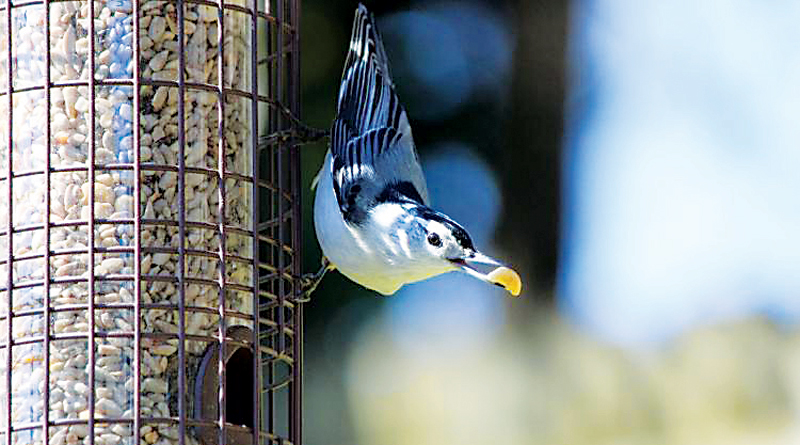UPSIDE DOWN BIRDS – Life In The Outdoors

Two nuthatches flew to the feeder outside the dining room window as I sat eating breakfast, and watching the birds outside, of course. Nuthatch, I read in a book titled “Words for Birds,” is a corruption of the word nuthack. And nuthatches do just that, hack at nuts. But they do it in a different position than any other birds. They stick a nut or a large seed, in the bark of a tree, then, as they cling to the bark above the nut they hack at, break it open, and eat it.
Nuthatches are upside down birds. They perch and feed with head down. One of the nuthatches that flew to my feeder as I watched landed, upside down, on a corner of a feeder, the other, also upside down, landed on one side of the feeder.
As a boy I thought nuthatches were named for their manner of perching, head down. They were nutty birds, I thought. But their name, I know now, has nothing to do with their position or orientation when they land.
The nuthatches at my feeder that morning were white-breasted nuthatch. White-breasts are common birds in woodlands and residential areas from southern Canada nearly to the Gulf of Mexico and from the East Coast to the West Coast. White-breasted nuthatches were among the first birds to the feeder I put out, with Dad’s help, when I was a boy.
White-breasted nuthatches do not migrate. I stock my feeders year-round and I have white-breasted nuthatches coming to them now, in winter, and in spring, summer and fall. Now, in winter, white-breasted nuthatches eat many seeds, as evidenced by their time at the seed feeders outside my windows. But they also eat many insects, when they can get them.
Nuthatch may seem like a strange name but white-breasted is appropriate. These birds are white breasted, and white throated and white on most of their head, all but a black cap, and on much of their belly. They have a dark blue back, wings, and tail but the wings and tail have white feather edgings making wings and tail look striped.
White-breasted is one of four species of nuthatch in North America. Another is the red-breasted, a somewhat smaller bird with a black cap, like the white-breasted, a white line above and a black line through each eye, a blue back, a white throat and an orange-red upper breast, belly and legs. This is a more northern nesting bird and a sporadic winter wanderer south of Canada. There is one coming to the feeders outside my dining room and study window this winter, some days but not every day.
A third nuthatch of the U.S. is the brown-headed. As the name states, it has a brown cap, not black like the white-breasted and red-breasted but it has a white throat and upper breast. It’s a bird of the south, southeast and east, eastern Texas into Florida and north along the East Coast into Virginia.
The fourth nuthatch of the U.S. is the pygmy. Its range is more limited than the range of the other nuthatches of the U.S. It’s a bird of yellow pine woodlands of the arid southwest, the four corners area, the only place in the U.S. where four states come together, of the southern coast of California and of an area in central Washington, Oregon and southern Canada.
Nuthatches nest in holes, frequently holes made by woodpeckers and abandoned. But they also nest in holes in rotting wood. I have seen white-breasted nuthatches feeding nestlings but have never seen nestlings leaving a nest. Are they upside down when they emerge? Do they fly out of the top or bottom of the hole?
I’ve finished breakfast. It’s time to go to my computer, and write about upside down birds, of course.
- Birds As Weather Forecasters – Life In The Outdoors - December 17, 2021
- Rare Bird Spotted In Indiana – Life In The Outdoors - October 8, 2021
- MY EXPERIENCE WITH DEER – Life In The Outdoors - July 30, 2021


